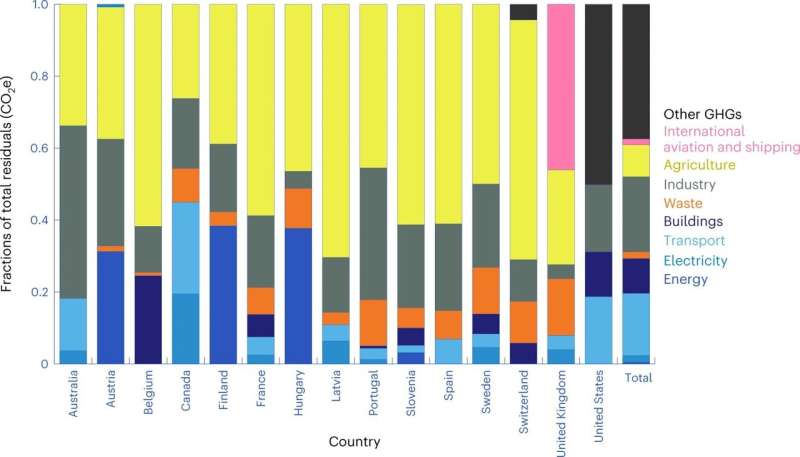This article has been reviewed according to Science X's editorial process and policies. Editors have highlighted the following attributes while ensuring the content's credibility:
fact-checked
peer-reviewed publication
trusted source
proofread
Often overlooked, 'residual emissions' are critical to fighting climate change

Humanity is not on track to avoid the deadliest effects of climate change, according to University at Buffalo researcher Holly Jean Buck. "Our plans are not adequate to meet the goal of limiting the Earth's temperature increase to no more than 1.5℃ by 2050," said Buck, Ph.D., assistant professor of environment and sustainability.
She is the lead author of "Why residual emissions matter right now," published recently in Nature Climate Change. Co-authors are Wim Carton, Ph.D., of Lund University in Sweden; Jens Friis Lund, Ph.D., of the University of Copenhagen in Denmark; and Nils Markusson, Ph.D., of Lancaster University in the United Kingdom.
"Residual emissions" are one obstacle to achieving the goal of net-zero greenhouse gas emissions. To limit the Earth's temperature increase, the United Nations' panel of scientific advisors says that the world must reach net-zero greenhouse gas emissions this century. Greenhouse gas emissions are a major cause of the rise in temperature.
Residual emissions are those that remain after efforts to eliminate such emissions have been implemented. For example, even with a concerted effort to eliminate all emissions, industries such as agriculture and shipping are likely to continue releasing greenhouse gases into the atmosphere. Residual emissions would need to be balanced by techniques that remove carbon dioxide from the atmosphere to meet net-zero goals—that is, any greenhouse gases entering the atmosphere are offset by those being removed.
Immediate steps to take
Buck and collaborators argue that a better understanding of residual emissions is essential to achieving net-zero. According to countries' long-term strategies, the average level of residual emissions by 2050 will be 18% of current emissions—an amount that cannot easily be offset by removing carbon.
They looked at long-term low-emission strategies submitted by 50 countries and found that only 28 even quantified the amount of residual emissions expected by 2050. Because managing residual emissions is critical to achieving the goal, Buck and her colleagues have identified several steps they say are necessary to tackle the problem.
The first is to develop clear projections for the amount of residual emissions. The amount, the source, and the type of gas—carbon dioxide or other greenhouse gases—need to be identified so that appropriate offsetting strategies can be developed. Such strategies include enhancing existing carbon sinks, which are anything that absorbs more carbon from the atmosphere than it releases. Naturally occurring carbon sinks include the ocean, forests and soil.
"We can enhance carbon sinks," Buck said. "We can plant trees, we can conserve land, we can engineer carbon removal, but it's not enough to bring us to net-zero by 2050 with these projections of residual emissions."
Another issue relating to residual emissions includes detailing the approach to net-zero: is it a temporary target pending further reduction of emissions, or is it meant to be a fix requiring permanent offsetting? Some carbon-emitting activities, such as aviation and shipping, are generally seen as truly hard to abate; other sources may be challenging for economic and political reasons, but technically feasible. Clarifying such issues establishes the groundwork for including residual emissions in strategies to achieve net zero by 2050.
Why net zero matters
What happens if the goal isn't met?
"More frequent floods," said Buck. "Devastating heat waves. Extreme economic damage from extreme weather. Agricultural production will be affected."
While the article identifies significant challenges to reducing residual emissions, it identifies those challenges as opportunities for research and cooperation. "We hope to affect policy makers and non-government organizations that are working to achieve net zero," said Buck. "We can achieve it. I'm hopeful we will."
More information: Holly Jean Buck et al, Why residual emissions matter right now, Nature Climate Change (2023). DOI: 10.1038/s41558-022-01592-2
Journal information: Nature Climate Change
Provided by University at Buffalo





















